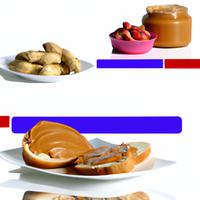
1 serving (100 grams) contains 300 calories, 10.0 grams of protein, 15.0 grams of fat, and 40.0 grams of carbohydrates.

Log this food in SnapCalorie

Nutrition Information
Calories |
714.3 | ||
|---|---|---|---|
% Daily Value* |
|||
| Total Fat | 35.7 g | 45% | |
| Saturated Fat | 7.1 g | 35% | |
| Polyunsaturated Fat | 0 g | ||
| Cholesterol | 0 mg | 0% | |
| Sodium | 952.4 mg | 41% | |
| Total Carbohydrates | 95.2 g | 34% | |
| Dietary Fiber | 7.1 g | 25% | |
| Sugars | 11.9 g | ||
| protein | 23.8 g | 47% | |
| Vitamin D | 0 mcg | 0% | |
| Calcium | 119.0 mg | 9% | |
| Iron | 4.8 mg | 26% | |
| Potassium | 476.2 mg | 10% | |
* Percent Daily Values are based on a 2,000 calorie diet. Your daily values may be higher or lower depending on your calorie needs.
Food Attributes
Source of Calories
About Bread roll with peanut butter
A bread roll with peanut butter is a simple yet satisfying snack or breakfast item. It typically involves a soft bread roll as the base, generously spread with creamy or crunchy peanut butter. While bread rolls are commonly associated with European and American cuisines, this pairing has global appeal due to its convenience and flavorful combination. Peanut butter, derived from roasted peanuts, is rich in healthy fats, protein, and essential nutrients like vitamin E, magnesium, and niacin, making it a good source of sustained energy. However, moderation is key, as some varieties may contain added sugars and salt. The bread roll itself provides carbohydrates, though its nutritional profile varies depending on whether it’s made from whole-grain or refined flour. Opting for a whole-grain bread roll can enhance fiber content and overall health benefits. This quick and portable option strikes a balance between indulgence and nourishment.



